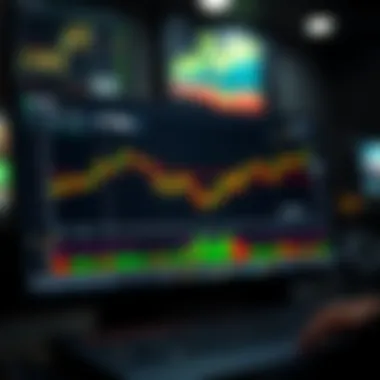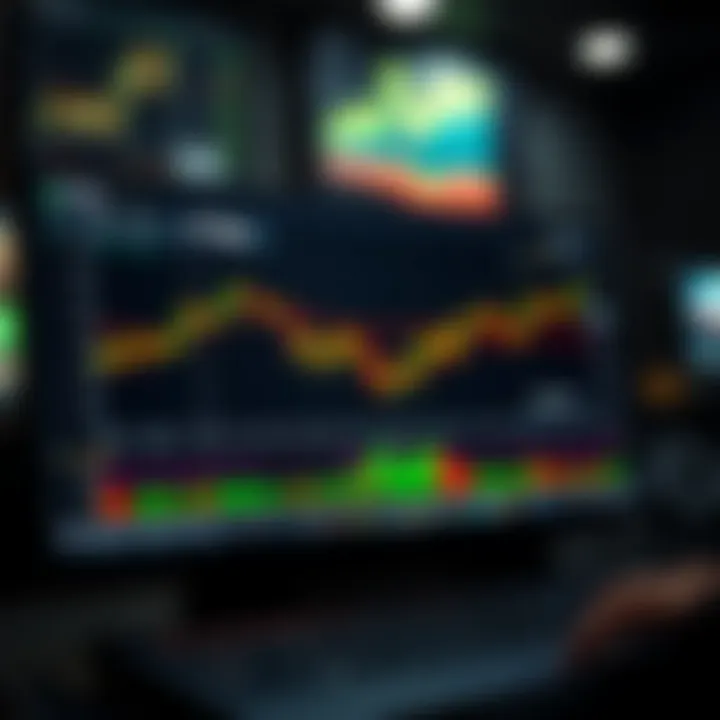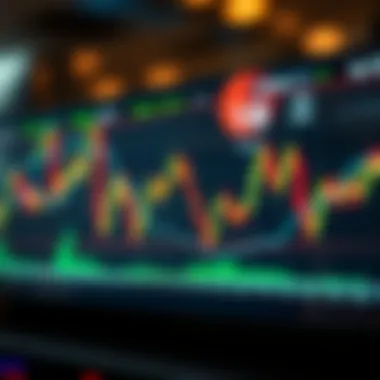Exploring FTM Trading on TradingView: Key Insights


Intro
In the intricately woven world of cryptocurrency, understanding the dynamics of various assets is crucial for any trader or investor. One such asset that has gained considerable traction is Fantom (FTM). The allure of FTM lies not only in its technology but also in the vibrant community and the innovative possibilities it presents through platforms like TradingView. This article aims to break down the significance of using TradingView as a tool to analyze FTM's performance. It outlines key concepts, market trends, and effective strategies to help traders navigate this ever-evolving landscape.
Key Concepts in Cryptocurrency
Definition and Importance
Cryptocurrency has dramatically changed the way we view and conduct financial transactions. At its core, it is a digital or virtual form of currency that relies on cryptography for security. The importance of understanding this conceptual framework goes beyond just knowledge; it empowers traders to make informed decisions. FTM, being a part of this landscape, possesses traits that exemplify the robustness of cryptocurrency assets.
Fantom, specifically, operates on a unique Directed Acyclic Graph (DAG) structure, which drastically enhances transaction speed and lowers fees. This aspect makes it appealing to both small-scale investors and institutional traders looking for efficiency. Understanding this not only allows traders to gauge FTM’s immediate value but also its long-term viability in a fluctuating market.
Blockchain Technology Overview
To fully grasp the potential of FTM, one must dive deep into blockchain technology—the backbone of cryptocurrency. Blockchain is a decentralized ledger that records all transactions across a network of computers. This decentralized nature enhances security and reduces the likelihood of fraud.
Fantom utilizes a modified version of this technology called Lachesis consensus, which enables instant finality of transactions, setting it apart from traditional blockchains that often struggle with transaction times. By understanding how blockchain works, traders can appreciate FTM’s position in the crypto ecosystem and its potential to disrupt traditional finance.
"In the world of finance, timing and knowledge are both invaluable. Embracing innovative technology equips traders to excel in a competitive environment."
Trends and Innovations
Emerging Cryptocurrencies
The cryptocurrency market is a bustling arena filled with new players surfacing almost daily. Amidst this surge, FTM stands out due to its unique features and applications. As traders look to diversify their portfolios, recognizing the impact of emerging cryptocurrencies is essential. Many investors are branching out from traditional assets like Bitcoin and Ethereum, seeking projects that offer stronger utility and increased scalability.
Technological Advancements in Crypto
Innovation in the cryptocurrency realm is relentless. With the rise of DeFi (Decentralized Finance), platforms like TradingView are equipped with advanced analytical tools. These tools help traders visualize market trends, enabling them to make data-driven decisions. For instance, the ability to use indicators such as RSI (Relative Strength Index) and MACD (Moving Average Convergence Divergence) in real time enhances traders' capabilities to capitalize on FTM's price movements.
Through TradingView, the incorporation of social and collaborative features allows users to share insights and strategies, thus enriching the trading experience. Keeping abreast of these innovations will not only help traders utilize FTM efficiently but also position them favorably in a profoundly competitive market.
By comprehending these fundamentals and keeping an eye on trends, traders and investors can better navigate the FTM landscape on TradingView, ultimately making more informed decisions as they explore this promising avenue of cryptocurrency.
Prologue to FTM and TradingView
In an era dominated by digital currencies, understanding specific platforms and tokens becomes crucial for traders. This section lays the groundwork for exploring the powerful attributes of Fantom (FTM) and how it can be effectively analyzed through TradingView. By illuminating the significance of both FTM and TradingView, this article aims to provide both seasoned and emerging market participants with the tools needed to make informed decisions.
FTM is not just another cryptocurrency; it's a blockchain platform known for its speed and scalability. Its role in decentralized finance (DeFi) and other applications cannot be underestimated. On the flip side, TradingView stands as a leading charting platform that offers real-time data and a plethora of tools for traders. Together, FTM and TradingView create a robust ecosystem that empowers users to dive deep into market trends, patterns, and analytics.
Key Elements of FTM and TradingView
- Fantom (FTM): As a high-performance blockchain, it facilitates fast transactions and low fees, making it appealing for developers and investors alike. It houses various projects that aim to improve efficiency in their operations.
- TradingView: Known for its user-friendly interface, TradingView allows users to create advanced chart analyses, integrate various indicators, and even share their insights with a community of traders. Its flexibility makes it a go-to tool for both casual traders and professional analysts.
In summary, the intertwining of FTM and TradingView not only enhances trading capabilities but also contributes to a better understanding of market dynamics. Through this exploration, we delve into the unique aspects of each, ensuring that readers leave with a well-rounded grasp of their significance.
The Relationship Between FTM and TradingView
Fantom (FTM) is gaining traction in the ever-evolving world of cryptocurrencies. As investors and traders seek effective ways to analyze and capitalize on price movements, the synergy between FTM and TradingView stands out. TradingView acts as a powerful ally, imbued with tools tailored for both novice and seasoned traders looking to dive into the depths of the FTM market.
Why Use TradingView for FTM Analysis?
TradingView, known for its robust charting capabilities, emerges as an indispensable resource for anyone looking to analyze FTM. The platform’s accessibility is a game changer. Whether you’re stacked up in your office or just kicking back at home, the ability to access powerful analysis tools anytime, anywhere cannot be overstated. Here’s a quick rundown of why
- Real-Time Data: Instant updates keep you ahead of market shifts. Knowing the pulse of FTM can mean the difference between seizing an opportunity or letting it slip away.
- Wide Range of Tools: Tools like trendlines, Fibonacci retracements, and volume indicators are just a few clicks away. They provide insights that are especially important in the volatile world of cryptocurrency.
- Community Insights: TradingView’s social network allows traders to share insights and strategies. This peer-driven knowledge can enhance individual trading approaches, making analysis a communal experience.
- Customizable Alerts: Set alerts based on specific price points or indicator values, ensuring you're notified when FTM behaves as anticipated.


With these features, the gap between mere observation and informed decision-making minimizes. Traders can dissect FTM’s price action not just based on intuition, but on a substantial analytical foundation.
Integration of TradingView with FTM Data
The integration of TradingView with FTM data magnifies the analytical experience. TradingView consolidates various data sources, presenting a holistic view of what’s happening with FTM at any given moment.
- Aggregation of Market Data: FTM’s performance is influenced by multiple factors—market sentiment, trading volume, and broader economic trends. TradingView integrates these diverse elements into a coherent narrative. You don’t just see lines and bars; you get a story.
- Visual Spectacle: Charts and graphs come alive on TradingView. This visualization helps traders recognize patterns or anomalies in FTM trading that might not be clear from numbers alone. Seeing a sudden spike on a candlestick chart is different from merely reading about it.
- Customizable Chart Types: Whether you prefer candlestick charts or line charts, you can adapt your workspace to what’s most comfortable for you. With FTM’s data interwoven with your preferred charting style, you gain insights tailored to your need.
In sum, the relationship between FTM and TradingView is anything but incidental. It cultivates an analysis framework that empowers traders, helping them navigate the complexities of the crypto market more effectively. This synergy champion the cause of informed, calculated trading strategies that can potentially lead to fruitful outcomes.
Utilizing TradingView for FTM Trading
Utilizing TradingView for trading Fantom (FTM) is akin to having a Swiss Army knife at your fingertips. This platform offers various tools and features that streamline the trading process and empower users to make informed decisions. By providing access to multiple charting techniques, analytical tools, and community insights, TradingView becomes a fundamental resource for both seasoned traders and newcomers looking to explore the crypto market. Choosing to use TradingView specifically for FTM trading is beneficial because it transforms the complexity of market data into a visual medium that is easier to understand and navigate.
Basic Chart Setup for FTM
Getting started with FTM on TradingView typically begins with setting up your basic chart. Begin by selecting a time frame that aligns with your trading strategy, whether you plan to day trade or hold positions overnight.
- Selecting the FTM/USD Pair: First off, ensure you select the correct trading pair. This could be FTM against the US Dollar or any other pair that suits your trading strategy.
- Choosing Your Chart Type: Moving averages are fundamental for trend analysis, so you might opt for candlestick charts which convey more information than standard line graphs.
- Adjusting the Time Frame: You can toggle between intervals like 1, 5, or 15 minutes to daily or weekly views for long-term observations.
- Incorporating Indicators: Add relevant indicators to your setup, which brings us to the next significant segment, leveraging technical indicators.
Leveraging Technical Indicators
Moving Averages
Among the most crucial technical indicators in trading FTM are moving averages. They serve as powerful tools for smoothing out price action and can help identify the broader trend that might not be visible on shorter time scales. The key characteristic of moving averages lies in their ability to filter out the noise in price fluctuations. They effectively allow traders to see the overall direction of FTM's price movement over specific periods.
The unique feature of using moving averages is that they can act as dynamic support and resistance levels. If you notice the price approaching the moving average and then bouncing off, it might signal a continuation of the trend. However, while moving averages are great, they can sometimes lag because they're based on historical data. This lag can potentially lead to missed entry points.
Bollinger Bands
Bollinger Bands take trading analysis up a notch by providing information about price volatility and market conditions. One of the main aspects to consider is that they consist of three lines: the middle band is a simple moving average, while the upper and lower bands are standard deviations from that average. This setup gives traders a clear view of potential price movement.
The key characteristic here is that the bands expand and contract according to market volatility. When the bands tighten, it often indicates a potential increase in volatility. This can be quite crucial in the FTM market where rapid price movements can occur. However, keep in mind that periods of low volatility can sometimes deceive traders into thinking that a big move is around the corner, only for the market to stagnate.
RSI and MACD
The Relative Strength Index (RSI) and the Moving Average Convergence Divergence (MACD) are indicators that many traders turn to for insight into FTM's market performance. The RSI measures the speed and change of price movements on a scale from 0 to 100, helping traders identify overbought or oversold conditions. Overbought typically indicates that a price correction might happen soon, whereas oversold suggests potential upward movement is likely.
As for MACD, it tracks the relationship between two moving averages of a security’s price. Its unique characteristic is its dual ability to show trend direction and momentum. Traders often look for crossovers between the MACD line and the signal line to determine when to enter or exit trades. But, while useful, relying solely on these indicators can lead to poor decisions if historical data does not reflect future price actions.
Overall, utilizing these technical indicators on TradingView offers a comprehensive toolkit for effectively trading FTM, it makes the process of analyzing market conditions more insightful.
Advanced Trading Strategies with FTM
In the dynamic landscape of cryptocurrency trading, developing advanced strategies can set successful traders apart from the rest. When it comes to FTM, the uniqueness of its market behavior and volatility adds complexity but also opportunity for savvy traders. Embracing sophisticated techniques allows traders to leverage fluctuations in the market for profits while managing risk effectively. In this section, we dissect how to navigate the complexities of FTM trading through day trading, swing trading, and long-term investment strategies.
Day Trading Techniques for FTM
Day trading is a strategy favored by many who prefer a rapid pace of trading. It involves buying and selling FTM within the same trading day; traders capitalize on short-term market movements. There are key techniques to implement:
- Scalping: This involves executing numerous trades throughout the day, targeting small profits on each trade. This requires sharp attention and an ability to read charts quickly. Traders often use short-term charts to identify quick entries and exits.
- Trend Following: Identifying the current market trend—uptrend or downtrend—is pivotal. Day traders can ride the wave, buying during an upward momentum and selling when the momentum begins to falter. Using the moving averages can smooth out these trends, making them easier to spot.
Day trading FTM isn’t for the faint of heart; it demands rigorous analysis and constant re-evaluation of strategies based on the latest market data. The adrenaline rush can be exhilarating, but without proper discipline, the risks of substantial losses loom large.
Swing Trading FTM Patterns
Swing trading focuses on taking advantage of price swings over a period of days to weeks. This approach allows traders to capitalize on market movements without needing to monitor charts constantly throughout the day.


- Identify Key Support and Resistance Levels: Recognizing these levels can provide insights on where FTM is likely to reverse or experience consolidation. Traders often place their trades around these levels, either entering long positions near support or short positions near resistance.
- Use of Candlestick Patterns: Familiarity with various candlestick formations—like engulfing or hammer patterns—can give traders clues about market sentiment. Understanding these patterns helps predict potential reversal points or confirmations of ongoing trends.
Swing trading is less stressful than day trading as it allows for more strategic planning and less on-the-spot decision-making. However, it is important to maintain a disciplined approach and to avoid emotional trading decisions.
Long-term Investment Strategies in FTM
Long-term investing strategies concentrate on holding FTM for extended periods, often looking beyond daily volatility. This strategy requires patience and a solid understanding of the underlying value proposition of FTM.
- Fundamental Analysis: An in-depth analysis of FTM—its use case, the technology backing it, market demand, and the overall ecosystem—is crucial for determining its long-term viability. Investors should monitor developments in the Fantom ecosystem and broader market trends.
- Dollar-Cost Averaging (DCA): By gradually accumulating FTM through regular purchases, investors can mitigate the impact of short-term price volatility. This method ensures that purchases happen at various price points, averaging out the total cost.
- Regular Portfolio Review: Long-term investors should regularly review their holdings to ensure alignment with their investment goals. This may involve reallocating FTM in response to market changes or new information.
In the end, a long-term investment strategy can yield significant returns. However, it necessitates belief in the asset’s future potential and a stomach for market swings.
As with all trading strategies, the key is to remain informed, disciplined, and adaptable—a trader's ability to adjust to changing market conditions is what often determines success.
Understanding FTM Market Metrics
Market metrics provide valuable insights into any cryptocurrency’s performance, and FTM is no exception. By gauging these metrics, traders can craft informed decisions and identify potential opportunities. The goal here is not merely to track prices but to understand the underlying factors that drive those prices.
Key Performance Indicators for FTM
Key Performance Indicators (KPIs) are essential metrics that help gauge the health and potential of a cryptocurrency like FTM. These include:
- Market Cap: This reflects the total value of all FTM in circulation. A higher market cap often indicates investor confidence and stability.
- Trading Volume: It reveals the number of FTM tokens traded in a specific period. High volume can suggest robust interest and participation in the market.
- Liquidity: This measures how easily FTM can be bought or sold without impacting its price. Higher liquidity often correlates with more stable price movements.
- Price Trends: Observing historical price trends alongside current movements can aid in forecasting future changes. Swing traders, for instance, often rely on these trends.
Collectively, these metrics form a comprehensive picture that can guide investment strategies and risk management.
Market Sentiment Analysis
Market sentiment involves understanding how traders feel about FTM, which can greatly influence price movements. Sentiment can swing between bullish and bearish based on news, technical developments, or general market conditions.
- Social Media Influence: Platforms like Reddit or Twitter often reflect market morale. Monitoring sentiment on these platforms can provide real-time insight into trader emotions.
- Google Trends: This tool can help gauge public interest in FTM over time, revealing peaks in searching activity that often correlate with price surges or drops.
- Surveys and Polls: Engaging directly with communities on platforms like Discord can surface trader sentiment and intentions.
Understanding market sentiment is crucial, as it can act as a predictive tool for price movements. Trader psychology often plays a subtle yet significant role in shaping the market landscape.
Interpreting FTM Price Movements
Understanding how to interpret FTM price movements is crucial for traders seeking to optimize their strategies. The dynamics of price can narrate stories about market sentiments, trends, and risks, influencing your trading decisions profoundly. When traders comprehend price action properly, they can increase their chances of making informed choices rather than sticking to merely guesswork or assumptions.
Analyzing Historical FTM Data
Historical data is like a treasure trove of insights. By looking back at past price movements of FTM, one can identify patterns that often repeat themselves. This analysis not only gives context to the current market conditions but also helps in predicting future movements.
Here are some factors to consider:
- Price Trends: Identifying whether FTM is in a bullish or bearish phase over the past weeks or months can substantially influence trading strategy. A clear uptrend could suggest investor confidence, while a downtrend might indicate potential sell-offs.
- Support and Resistance Levels: These are critical price levels at which an asset struggles to pass above or below. By marking these levels on charts, traders can spot areas where historical price movements turned around, which can signal future price actions.
- Volume Analysis: Volume often accompanies price movement; a spike in volume typically supports the direction of the price change. Conversely, a price movement with low volume may not hold, providing clues about momentum.
By diving deeply into the historical data of FTM, traders can make clearer, data-driven decisions. It’s essential to remember that past performance doesn’t guarantee future results but serves as a valuable indicator.
Understanding Volatility in FTM
Volatility reflects how much the price of an asset swings over a specific period. High volatility in FTM can present both risks and opportunities. If you want to profit from trading, grappling with volatility is necessary.
Factors that affect volatility include:
- Market Sentiment: When investors become more optimistic, prices tend to climb quickly, resulting in high volatility. On the flip side, fear can cause rapid declines, emphasizing the emotional elements behind trading decisions.
- External Events: News, regulatory changes, or technological developments can greatly impact FTM’s volatility. It’s crucial to stay informed, as such events often lead to unpredictable price swings.
- Liquidity: A more liquid market typically has less volatility, while a thinly traded asset like FTM may experience sharper price movements due to fewer buyers and sellers.


"In the world of trading, understanding volatility isn't just nice-to-have; it's a matter of survival. You must embrace it to navigate the treacherous waters of the market successfully."
By grasping the nuances of volatility, traders can better prepare their strategies, employing techniques such as stop-loss orders or options to manage risk effectively. Successful traders navigate fluctuations, viewing them as chances rather than threats.
Expert Opinions on FTM Trading
In the tumultuous landscape of cryptocurrency trading, expert opinions act like a lighthouse in a stormy sea. Understanding what seasoned traders have to say about FTM trading can significantly boost one’s decision-making process. Professional traders often share insights derived from years of experience, analyzing not only the numbers but also the emotional components involved in trading strategies. Their perspectives can reveal nuances that average investors might overlook, effectively illuminating the path to successful trading endeavors.
Engaging with these insights could elevate a trader’s strategy to new heights. Incorporating expert analysis encourages traders to consider a variety of viewpoints and techniques, fostering a more well-rounded approach to the trade. Moreover, such insights often touch upon the psychological aspects of trading, highlighting how emotional intelligence can play a pivotal role.
Insights from Professional Traders
According to industry veterans, one useful perspective revolves around the significance of timing when trading FTM. They emphasize that decisions should not be purely based on technical indicators but must also account for market sentiment.
- Research Market Trends: Staying attuned to the broader cryptocurrency landscape enables traders to anticipate movements. Market trends can be influenced by regulatory changes, macroeconomic conditions, and adoption rates of blockchain technology.
- Technical vs. Fundamental Analysis: While technical analysis is crucial for short-term gains, understanding fundamental principles behind FTM can help define long-term strategies. An expert might note that an investor should have a steadfast grasp on the FTM’s underlying technology and its actual use cases. This understanding fosters confidence and can lead to more considerate trading choices.
- Networking: Professional traders often talk about the value of networking within the crypto community. Sharing experiences can lead to discovering tools and techniques that might not be widely known, giving one a competitive edge.
"Trading is not just about numbers; it's about understanding the heartbeat of the market," states a well-known crypto analyst.
Common Pitfalls in FTM Trading
While engaging with expert opinions, it's also crucial to be aware of potential pitfalls that can derail even the most seasoned traders. Here are some common traps:
- Chasing Losses: In their desire to recover losses, traders often make impulsive decisions. Recognizing when to step back and reassess is key to maintaining a sound strategy.
- Over-Leveraging: One major risk is the tendency to use high leverage without understanding the risks involved. This could lead to significant losses which may not be easy to recover from.
- Ignoring Overall Market Sentiment: Markets do not operate in a vacuum. Ignoring broader trends can result in unexpected losses, as many FTM traders have discovered when market sentiment shifts.
- FOMO (Fear of Missing Out): Impulse trading due to fear of missing out on potential gains leads to hasty decisions that often do not hold up under scrutiny.
In summary, whilst expert opinions can guide traders toward success, it's equally important to be aware of the common pitfalls in trading. A balanced approach integrating insights with caution can lead to a more productive trading experience with FTM on TradingView.
Future Perspectives on FTM and TradingView
As we navigate the dynamic landscape of cryptocurrency trading, understanding the future of Fantom (FTM) on TradingView becomes increasingly paramount. This section unpacks not just the potential growth of FTM but also how TradingView can evolve as a pivotal tool in that journey. With the rapid advancements in technology and shifting market sentiments, traders and investors need to keep their pulse on emerging trends.
Predictions for FTM Market Trends
Market predictions are never set in stone; they're more like a weather forecast—useful, but not infallible. However, there are key factors worth considering when mapping the future of FTM:
- Adoption Rate: The number of projects choosing to build on Fantom’s platform could indicate its upward trajectory. If more decentralized applications (dApps) embrace Fantom, the demand for FTM may surge.
- Technological Improvements: New upgrades or partnerships can often catalyze growth. Keep an eye on any significant developments regarding scalability or transaction speed improvements.
- Market Sentiment: Social media can amplify community perceptions. Following discussions on platforms like Reddit or Twitter might reveal underlying trends that could affect FTM's value.
Analyzing these trends suggests that FTM could experience a bullish shift, especially if wider market conditions remain favorable. A price point analysis using TradingView's charting tools can assist traders in positioning themselves for optimal entries.
The Role of TradingView in Future Trading
TradingView is more than just a charting tool; it's like the Swiss Army knife for traders. Its wide array of features enhances understanding, strategy development, and execution.
- Advanced Charting Capabilities: As cryptocurrency evolves, having access to sophisticated charting tools can help traders make informed decisions. TradingView’s portfolio of features, like customizable indicators and multiple chart layouts, allows for tailor-made strategies that fit individual trading styles.
- Community Engagement: TradingView isn't just a tool; it's a vibrant community of traders. This social aspect allows for the sharing of insights, whether through exchanging ideas or discussing market movements. If you’re active on TradingView, you become part of a collective intelligence which can often lead to improved trading outcomes.
- Integration with Various Exchanges: As more exchanges adopt FTM trading, TradingView's integration ensures that traders remain connected to the latest FTM data. Real-time updates are crucial during heightened market activity.
Epilogue
Bringing everything together, the conclusion of this article sheds light on the numerous opportunities and hazards that come with trading Fantom (FTM) on TradingView. The insights provided throughout emphasize the importance of leveraging robust charting tools, market metrics, and expert opinions in crafting successful trading strategies for FTM. This analysis invites investors to not just skim the surface of trading but to dive deeper into the complexities of price movements and market behaviors that impact FTM exchanges.
Summarizing the Key Takeaways
In summarizing the key takeaways:
- TradingView as a Catalyst: Using TradingView fortifies one's trading capabilities, providing essential tools for understanding FTM price dynamics.
- Technical Analysis Techniques: Gleaning insights from candles, indicators, and historical data can strategically inform trading tactics, whether day trading or considering longer-term investments.
- Market Awareness: Analyzing market sentiment and performance metrics can influence not just individual trades but the trader’s overall strategy in the competitive crypto landscape.
"Understanding the tools at your disposal can make or break your trading journey. With FTM, effort in learning could yield hefty rewards."
Final Thoughts on FTM Trading
To wrap it up, the journey of trading Fantom on TradingView isn’t just about numbers and charts. It’s a blend of emotional intelligence, analytical prowess, and the willingness to adapt to ever-shifting market conditions.
Successful investors tend to focus on developing their trading styles based on acquired knowledge rather than following the herd. How you analyze the data, read market signals, and make decisions will ultimately shape your outcomes. The confluence of strategic analysis and informed trading through TradingView can significantly enhance one's experience as an FTM trader.
Stay curious, keep questioning the market dynamics, and never underestimate the power of a well-informed decision.















